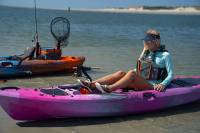2nd-Ever CA-to-HI Solo Kayak Trip Demands Persistence, Patience
Cyril Derreumaux has completed his solo kayak trip from California to Hawaii. He arrived at Hilo on Sept. 20 after 92 days at sea. He’s only the second person to make the arduous journey by kayak.
Editor’s note: This article was originally published on Explorersweb.
Cyril Derreumaux pushed off from Monterey, Calif., on June 21 in the company of well-wishers paddling a few strokes beside him. Then came 3 months of lonely effort. He had initially hoped to complete the 2,761-mile trip to Waikiki, Hawaii, in 70 days, but difficult conditions slowed his progress.
However, the seasoned paddler eventually prevailed. Success must taste even sweeter in the memory of his previous attempt, which ended after just 6 days and 70 miles.

A Rough Start
For the first few weeks, contrary winds pushed Derreumaux in the wrong direction. Rather than making progress, the daily goal became not losing distance. Constant swells made him seasick, and he felt very weak. On week two, the tubing that held his steering line disconnected and let water into the cabin.
Then after 46 days, his watermaker broke. From that point on, as well as rowing for 10 to 12 hours a day, he also spent 1-1.5 hours manually generating fresh water. And he spent several bad-weather days in his little cabin, on sea anchor.
It quickly became clear that the journey would take more than 70 days. By the halfway point, he started rationing food. Though he had calculated 6,000 calories a day to fuel all that rowing, he lost weight rapidly, even before rationing. With it, he began to doubt whether he would make it in time.
At the end of August, he decided to change his Hawaiian endpoint. Rather than land in Waikiki, he redirected to Hilo. This cut 6 days of paddling from the journey. It also meant that he had enough food to make the distance without resorting to eating toothpaste, like the first California-to-Hawaii kayaker, Ed Gillet, had done.
View this post on Instagram
Staying Entertained: Music, Seinfeld, and Dolphins
Derreumaux entertained himself by listening to music almost constantly. Before leaving, he had even downloaded Seinfeld to watch at night when he wasn’t rowing.
Along the way, he enjoyed watching dolphins swim and jump around the boat. By the end, hundreds of them had come to visit. Over the last few days of the voyage, he even had schools of mahi-mahi following him.
“A mahi-mahi pet fish followed me all day, I loved it!” he wrote on social media. “[It] left me yesterday morning. I guess he did not like when I played Celine Dion.”
As the journey progressed, Derreumaux became more relaxed and attuned to his surroundings. He found not seeing himself in a mirror to be a very “freeing experience.” He also established a kind of symbiosis with his custom-made boat, “Valentine.”
“I know her so well now,” he said. “I know how she behaves in what kind of waters, I know all the noises she makes and what they mean, I could find anything in the dark … it’s very special.”
View this post on Instagram
Ed Gillet’s Example; Overcoming Failure
Ed Gillet’s original 1987 journey first inspired Derreumaux. Gillet was far less high-tech. He used an off-the-shelf kayak — no sleeping cabin, no extended storage — and had no means of communication for most of the journey. After 3 weeks at sea, Derreumaux said, “I am more in awe of Ed Gillet and what he accomplished [than ever].”
He first attempted the journey in 2021 but needed rescue after 6 days. Storms and swells damaged his boat and caused water to leak into the cabin. With conditions set to worsen, he abandoned the crossing.
But despite that embarrassing end, Derreumaux channeled the failure into improving his technique and boat.
View this post on Instagram
He modified the sea anchor system, installed a satellite communication system, and added both a manual bilge pump and side panels to keep water out of the cockpit. He also trained to be more familiar with how his kayak behaved in high winds, he told Honolulu’s KHON 2.
This was not Derreumaux’s first time crossing the ocean from California to Hawaii. In 2016, he and his teammates broke the speed record for rowing in the Great Pacific Race. Paddlers have since broken the mark, but the four-man team covered the roughly 2,800 miles from Monterey, Calif., to Oahu, Hawaii, in 39 days, 9 hours, and 56 minutes.

In the end, adjustment, experience, and persistence all added up to success for the paddler. He signed off on his 92-day voyage with messages of gratitude to his supporters and team.
The post Second-Ever CA-to-HI Solo Kayak Trip Demands Persistence, Patience appeared first on GearJunkie.

